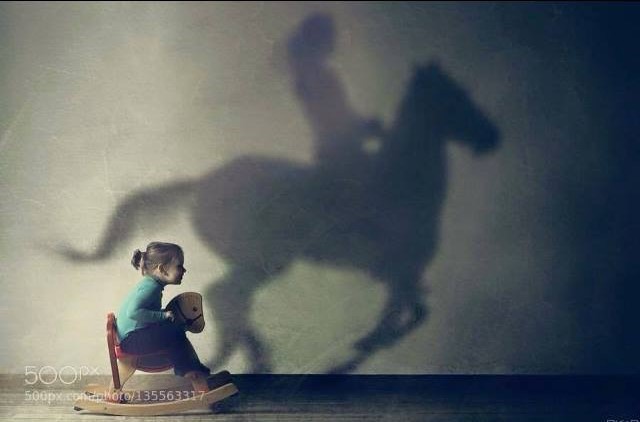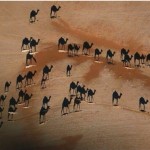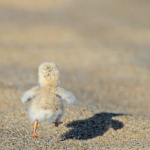
Casting Shadows
Recently, I ran across a video of children discovering their shadows for the first time. Their reactions range from fascination to uncertainty to outright fear. Imagine! Here you are minding your business on a bright, sunny day and suddenly a dark figure appears who (the audacity!) mimics your every move.
Once we grasp that our shadows aren’t out to get us, and assuming they’re not the rascally runaways like the shadow of the unfortunate Peter Pan, we learn how to manipulate them. A tree outside my childhood bedroom cast long shadows on the wall in the evenings. I’d form my hands into shadow puppets of birds, which flew about its branches, landing and taking off with dramatic flutters. A talented friend of ours made comical bunnies, menacing wolves, and cunning crocs come alive with just his hands and a spotlight.
A shadow is, after all, just a projection made from light. This mind-bending photo by  George Steinmetz shows an overhead image of shadows cast by a caravan of camels trekking across the desert sands. What earned this picture its status as one of 2005’s best photos of the year (National Geographic) is that if you look closely, you see the camels are actually the thin white lines. The dark recognizable camel shapes are all camel shadows. Whaaat?! Go ahead, enlarge it and see.
George Steinmetz shows an overhead image of shadows cast by a caravan of camels trekking across the desert sands. What earned this picture its status as one of 2005’s best photos of the year (National Geographic) is that if you look closely, you see the camels are actually the thin white lines. The dark recognizable camel shapes are all camel shadows. Whaaat?! Go ahead, enlarge it and see.
The light, directed just so, projects an image that creates a much greater impression than the object itself. Perspective is slippery. Had this photo been captured at a different time of day, the camel shadows would have instead been long wavy lines trailing behind the caravan. Nothing special. When the light is strongest and at its best for creating projections, it changes what we see of ourselves; it changes how we are seen by others.
The shadows we cast change over time, or maybe it’s that time changes the shadows we cast. In the morning of life, when we are unsure and unsteady, the strength of our shadow may frighten us, like the children in the video, and send us scurrying back into the comfort of shade. Later, conditioned by rejection, loss, or a shaky belief in who we are or what we can be, it’s much easier to stand in someone else’s shadow rather than risk casting our own. We don’t trust what the light might reveal, or perhaps we have our own idea what might be projected and we fear it’s more like a misshapen weasel than a swan.
Once upon a time, we might have been a child on a rocking horse or a wobbly duckling running for cover. A few along the way, parents, treasured teachers, a best friend, see us for who we are meant to be, who know what treasures lie within. They see us from above in the afternoon, and to them the rocking horse seems a galloping stallion, the duckling a darting hummingbird.
One day, we grow tall enough and brave enough to  stride into the day with confidence, casting our own shadows boldly and realize what we have been all along. Armed with grace, we see what our own two hands are capable of shaping onto the wall, when we let the light in.
stride into the day with confidence, casting our own shadows boldly and realize what we have been all along. Armed with grace, we see what our own two hands are capable of shaping onto the wall, when we let the light in.
Now, well into my fourth decade, I feel more comfortable in my own skin than at any other time I can remember. It feels good to stretch my muscles in the sunlight, and I find myself lingering to soak up its warmth. I’m more curious than afraid of what images its rays will scatter.
We, as a matter of course, extend this powerful light-wielding vision to our children, family, friends, and even strangers. Why is it we so often withhold it from ourselves and keep our shadow casting small and timid? Standing in the shade, we throw no shadow at all. Our canvases are empty. Afraid to be just ducklings, we never see the hummingbird’s gossamer wings flickering in the sun.
The truth is we are all a bit of both: ducklings and hummingbirds, camels and thin white lines. Each comes from the other; each is lovely and full of light. Don’t wait for permission, perfection, or “the right time.” Cast your shadow, big and bold.
